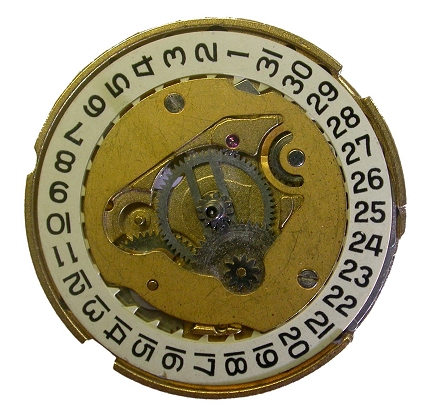

 |
 |
| 2302 front (dial side) view. | 2302 back view. |
| Manufacturer: | Bulova Watch Company Inc. |
| Dimensions: | 19.4mm or 23.5mm x 5.2mm |
| Commencement of Manufacture: | 1970 |
| Tuning Fork Frequency: | 480 Hz |
| Index Wheel: | 240 teeth |
| Derived Calibres | 2301, 2302, 2303, 2312, 2313 |
The Model 230 Accutron was the first tuning fork movement small enough to be offered as a Ladies watch. It was available in two basic sizes, the only difference being the bottom or pillar plate. The larger size (23.5mm) was used in men's watches also. It could be obtained with or without a sweep second hand. The electronic circuitry had been miniaturised from previous tuning fork watches, and had one set of disk-shaped coil windings which extended between the magnetic ends of both of the tuning fork tines.
One of the unusual features of the 230 series movements is the shape of the train wheel teeth. At first glance they appear almost triangular in shape, rather than the epicycloid-hypocycloid shape normally seen in watches. But just not quite. Then, on looking at the overall size and layout of this movement, it soon becomes clear that there may be a good reason for this. There is very little room in this movement for the wheel train. This movement uses a 344 cell, same size as in a 218 movement. The 230 series movement draws the same current as a 218, so it needs the same size cell to give a year or more run time. The battery uses 35% of the area of the movement, but the remaining 65% is a very awkward shape and hard to use efficiently. But efficiently is exactly what Bulove did when they designed this movement. The challenge of achieving the reduction ratios required in such a confined space was met by having very small pinions of mainly 6 teeth, and large wheels with a high tooth count, and arranging them in vertical "layers". The table below gives the ratios:
| 230 | Sweep Sec. | Center Wheel | 4th Wheel | 3rd Wheel | 2nd Wheel | Index Wheel |
|---|---|---|---|---|---|---|
| Wheel | -- | 60 | 96 | 72 | 60 | 240 |
| Pinion | 8 | -- | 12 | 8 | 6 | 6 |
In other words, the following ratios:
While the above unusual ratios may to some extent explain the odd tooth forms, I am not entirely sure that is the only reason. Watch pinions of normal hypocyloidal shape are never smaller than 6 leaves, because the leaves become quite thin, and require much greater manufacturing accuracy to make them a true "rolling contact" shape. So in a regular mechanical watch, 6 leaf pinions are only found on escape wheels and sometimes indirect seconds pinions, where the forces are small and less likely to cause problematic wear. In a regular mechanical watch, variations in transmitted force due to tooth shape and rolling friction has a very signicant effect on timekeeping. Higher grade mechanical watches almost always use a minimum of 8 leaf pinions, which are more wear-resistant, lower friction and easier to make. However, in Accutrons, friction and torque variation is of much less significance than in a mechanical watch, as the wheel train is a "driving" type ie. the force driving the train is small and originating at the smallest wheel and driving up through the train to turn the hands. In a mechanical watch, the train is "driven" ie. the driving force (the mainspring) is large, and is transmitted down through the train to the escapement, which holds the big force back, like sticking your finger in a hole in a dam wall.
So, with that in mind, I suggest Bulova developed their own unique tooth shape to allow very small diameter 6 leaf pinions to be made easily and accurately enough, and more robust too. The resultant pinion tooth form requires an almost straight-sided wheel tooth, making them look a bit triangular. Though this compromised shape would result in a bit more rolling friction. this would not affect the timekeeping of the Accutron at all. And, as the forces transmitted through the train are so small, they would probably run for hundreds of years before there was much wear anyway. In fact, I have seen 230's that have been in regular use for 35+ years, and shown no sign of wear at all on the train. You don't see this tooth form on other Accutrons, because the 230 series were the last unique series to be designed, except the 2210, and the 219 and 224 movements were based on the earlier 218 design. As for the 2210, they presented a whole new set of design problems, so check that page to see how they overcame them.
Incidentally, the 230 has the smallest index wheel of all the Accutron watches. It is a tiny 1.7mm (0.067") diameter, with 240 teeth. A really amazing feat of manufacturing.